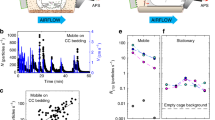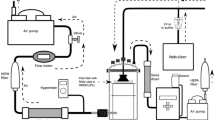Abstract
We studied some important aspects constituting aerosol transmission of Hantaan virus, including the possibility of viral aerosol generated by rodents, airborne stability, rodent’s susceptibility to aerosol challenge, and field air sampling for the virus. Our results showed that Hantaan virus aerosol could be generated through the activities of infected mice, and cause specific infection among the exposed animals. Several kinds of rodents such asApodemus agrarius, weaning mice and suckling mice were found to be rather sensitive to the aerosol challenge of Hantaan virus. The 50% of inhaled lethal dose (LD50) of suckling mice is 0.73 (1.4–0.37) plaque-forming unit (pfu). Hantaan virus aerosol was relatively stable in the air at 18–20°C and 70–90% relative humidity. The biological decay rate of the viral aerosol was 4.1% per min during 90 min. We also successfully sampled and isolated Hantaan virus from the working field atmosphere. The data obtained in the study provided more solid evidence for Hantaan virus aerosol transmission among rodents and from rodents to human-beings.
Similar content being viewed by others
References
Cai ZL, Xu HM, Keng IG, Xu CH, Li CY, He YX. Study on food transmission of hemorrhagic fever with renal syndrome. Chin J Public Health 1988;7:85–6.
Cai ZL, He YX, Win QL, Lu CX, Hu ML. Experimental study on infection of BALB/c mice and guinea pigs via skin and mucosa. Chin J Zoonoses 1992;8(3):59–60.
Casals J, Hoogstraal H, Johnson KM, Selokov H, Wiebenga WH, Work TH. A current appraisal of hemorrhagic fever in the USSR. Am J Trop Med Hyg 1966;15:751–64.
Che FX, He YX, Li ZD, Wu GH. Transmission Route and Prevention of Hemorrhagic Fever with Renal Syndrome. Beijing: Da Bai Ke Quan Shu Publisher, 1996:1–317.
Chen HX, Lu RH. Epidemiological monitoring to HFRS of China. Chin J Vector Control 1991;2(1):30–7.
Demyster J, Leduc JW, Johnson KM, Brasseur F, Decker C, De Strihou CVY. Laboratory rat associated outbreak of hemorrhagic fever with renal syndrome due to Hantaan-like virus in Belgium. Lancet 1983;2:1445–8.
Dimmick RF. An Introduction to Experimental Aerobiology. New York: Wiley Interscience, 1969:1–121.
Hughes JM, Peters CJ, Cohen ML, Mahy BWJ. Hantaan virus pulmonary syndrome: a emerging infectious disease. Science 1993;262:850–1.
Lee HH, Dalrymple JM. Manual of Hemorrhagic Fever with Renal Syndrome. WHO Collaborating Center for Virus Reference and Research (Hemorrhagic Fever with Renal Syndrome). Korea University: Institute for Viral Diseases, 1989:1–123.
Lee HW, Lee PW, Baek LJ, Song CK, Seong IW. Intraspecific transmission of Hantaan virus, etilogical agent of Korean hemorrhagic fever, in the rodentApodemus agrarius. Am J Trop Med Hyg 1981;30:1106–12.
Lee HW, Lee PW, Johnson KM. Isolation of the etiologic agent of Korean hemorrhagic fever. J. Infect. Dis. 1978;137:298–308.
Li ZD, He YX, Sung GC, He JF. Isolated HFRS virus from blood of human by Vero E6. Chin J Epidemiol 1983a;4(4):198–201.
Li ZD, Jiang YT, Song GC, Li DL, He JF, He YX, Li ZY, Ren LY, Liu JQ. Isolation of virus of hemorrhage fever with renal syndrome (HFRS) directly from patient’s blood through Vero-E6 cell system. Int J Microbiol 1983b;1:47–54.
Li ZD, Song GC, He JF. Study on plaque forming unit for HFRS virus. J Acad Milit Med Sci 1991;15(1):19–21.
Lin QF, Liu YX, Ling FC, Hung WM. Statistics of Environmental Medicine. Beijing: People-Health Publisher, 1989:251–259.
Liu JQ, Li ZY, Shin BJ, Cai ZL, Jing XT, Wein QL. Observation of the vertical transmission of Hantaan virus in Rattus norvegicus. China J Public Health 1988;7:15–7.
Lu JC, Che FX, Jia JW, Meng LY, Xu XC, et al. TK model microbiological aerosol nebulizer. In: Che et al, editors. Transmission Route and Prevention of Hemorrhagic Fever with Renal Syndrome. Beijing: Da Bai Ke Quan Shu Publisher, 1996:148–155.
Luo C, Wang Y, Lu T, et al. The effect of aerosol on transmission of EHF among laboratory animals. An Hui Md 1991;12:7.
May KR, Happer GJ. The efficiency of various liquid impinger in bacterial aerosols. Br J Ind Med 1957;14:287–90.
Nichol ST, Spiropoulou CF, Morzunov S, Rollin PE, Ksiazek TG, Feldmann H, Sanchez A, Childs J, Zakis S, Peters CJ. Genetic identification of a Hantaan virus associated with an outbreak of acute respiratory illness. Science 1993;262:914–7.
Nuzum EO, Rossi CA, Stephenson EH, Leduc JW. Aerosol transmission of Hantaan and related viruses to laboratory rats. Am J Trop Med Hyg 1988;38:636–40.
Rosebury T. Experimental Airborne Infection. Baltimore: William&Wilkins, 1947.
Zhang Y, Zhang BG, Deng XZ, Seng JZ, Bao MR, Zhao XZ, Wu GH. Experimental observation on the transmission of epidemic hemorrhagic fever virus amongApodemus agrarius through biting of Gamasid mites. Jiangsu Med J 1986;11:585–6.
Author information
Authors and Affiliations
Corresponding author
Rights and permissions
About this article
Cite this article
Fengxiang, C., Jianchun, L., Lingyin, M. et al. Study on the aerosol transmission of Hantaan virus. Aerobiologia 14, 333–339 (1998). https://doi.org/10.1007/BF02694302
Received:
Accepted:
Issue Date:
DOI: https://doi.org/10.1007/BF02694302




